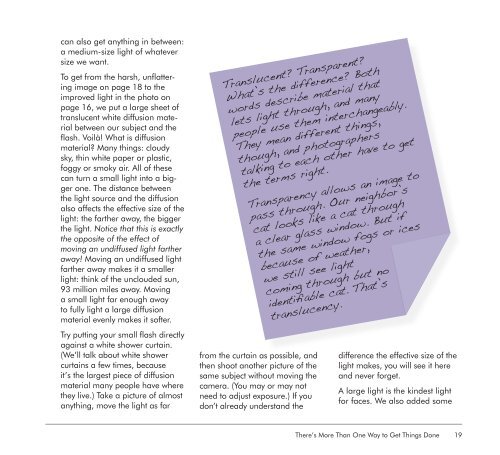Focus On Lighting Photos Focus on the Fundamentals.pdf
Create successful ePaper yourself
Turn your PDF publications into a flip-book with our unique Google optimized e-Paper software.
can also get anything in between:<br />
a medium-size light of whatever<br />
size we want.<br />
To get from <strong>the</strong> harsh, unflattering<br />
image <strong>on</strong> page 18 to <strong>the</strong><br />
improved light in <strong>the</strong> photo <strong>on</strong><br />
page 16, we put a large sheet of<br />
translucent white diffusi<strong>on</strong> material<br />
between our subject and <strong>the</strong><br />
flash. Voilà! What is diffusi<strong>on</strong><br />
material? Many things: cloudy<br />
sky, thin white paper or plastic,<br />
foggy or smoky air. All of <strong>the</strong>se<br />
can turn a small light into a bigger<br />
<strong>on</strong>e. The distance between<br />
<strong>the</strong> light source and <strong>the</strong> diffusi<strong>on</strong><br />
also affects <strong>the</strong> effective size of <strong>the</strong><br />
light: <strong>the</strong> far<strong>the</strong>r away, <strong>the</strong> bigger<br />
<strong>the</strong> light. Notice that this is exactly<br />
<strong>the</strong> opposite of <strong>the</strong> effect of<br />
moving an undiffused light far<strong>the</strong>r<br />
away! Moving an undiffused light<br />
far<strong>the</strong>r away makes it a smaller<br />
light: think of <strong>the</strong> unclouded sun,<br />
93 milli<strong>on</strong> miles away. Moving<br />
a small light far enough away<br />
to fully light a large diffusi<strong>on</strong><br />
material evenly makes it softer.<br />
Try putting your small flash directly<br />
against a white shower curtain.<br />
(We’ll talk about white shower<br />
curtains a few times, because<br />
it’s <strong>the</strong> largest piece of diffusi<strong>on</strong><br />
material many people have where<br />
<strong>the</strong>y live.) Take a picture of almost<br />
anything, move <strong>the</strong> light as far<br />
Translucent? Transparent?<br />
What’s <strong>the</strong> difference? Both<br />
words describe material that<br />
lets light through, and many<br />
people use <strong>the</strong>m interchangeably.<br />
They mean different things,<br />
though, and photographers<br />
talking to each o<strong>the</strong>r have to get<br />
<strong>the</strong> terms right.<br />
from <strong>the</strong> curtain as possible, and<br />
<strong>the</strong>n shoot ano<strong>the</strong>r picture of <strong>the</strong><br />
same subject without moving <strong>the</strong><br />
camera. (You may or may not<br />
need to adjust exposure.) If you<br />
d<strong>on</strong>’t already understand <strong>the</strong><br />
Transparency allows an image to<br />
pass through. Our neighbor’s<br />
cat looks like a cat through<br />
a clear glass window. But if<br />
<strong>the</strong> same window fogs or ices<br />
because of wea<strong>the</strong>r,<br />
we still see light<br />
coming through but no<br />
identifiable cat. That’s<br />
translucency.<br />
difference <strong>the</strong> effective size of <strong>the</strong><br />
light makes, you will see it here<br />
and never forget.<br />
A large light is <strong>the</strong> kindest light<br />
for faces. We also added some<br />
There’s More Than <str<strong>on</strong>g>On</str<strong>on</strong>g>e Way to Get Things D<strong>on</strong>e<br />
19



